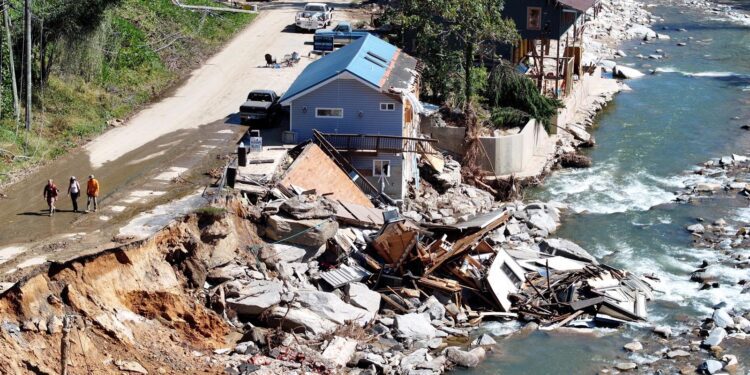September 2024 was Earth’s second-warmest September on record behind September 0f 2023, said the European Copernicus Climate Change Service and the Japan Meteorological Agency (JMA). Data for September from NOAA’s National Centers for Environmental Information (NCEI) and from NASA are not yet available, since NCEI’s headquarters in Asheville, North Carolina, was severely impacted by Hurricane Helene on Sep. 27. Helene is being blamed for 247 deaths, making it the fourth-deadliest U.S. hurricane since at least 1963. Human-caused climate change increased the hurricane’s rainfall in the Asheville region by around 10%, making what used to be a 1-in-115-year event now a 1-in-70-year event, said the World Weather Attribution group.
NCEI headquarters in Asheville, NC, has been severely impacted by Hurricane Helene. We’re grateful to report that all employees and staff have been accounted for and all data holdings are safe, though archived data is currently unavailable.
More info: https://t.co/AW3L6NrqAl pic.twitter.com/IpVjtJbSib
— NOAA NCEI (@NOAANCEI) October 4, 2024
The European Copernicus Climate Change Service and climate scientist Zeke Hausfather say 2024 is virtually certain to be the warmest year on record.
🔥🔥🔥 Global temperature ranking for September 2024 compared to all other Septembers since 1940. This was the second warmest September on record (2023). Nearly 15% of the globe had their single warmest September. pic.twitter.com/XhQ96c1Yqi
— Brian Brettschneider (@Climatologist49) October 5, 2024
Satellite-measured temperatures of the planet’s lower atmosphere (the lowest few miles) were the warmest on record globally for any September.
According to climatologist Brian Brettschneider, September 2024 was the second-warmest September on record for the contiguous U.S., behind September 1998. September was also a month of precipitation extremes, with catastrophic flooding in parts of the Southeast from Hurricane Helene, and exceptional dryness in the northern Plains and Great Lakes. The nationwide extent of severe drought is not yet especially large, but just over 75% of the contiguous U.S. reported at least some level of abnormal dryness (D0–D4 on the U.S. Drought Monitor). This is the highest percentage in nearly two years, since December 2022, and it is not far off the record high of 76.16% in data going back to 2000.
🔥🔥 September 2024 was a very warm month in the Contiguous U.S. According to the Prism dataset, it was the warmest September for large areas of the western and north central U.S. and for the southern half of Florida. Overall, Prism has this as the 2nd warmest September (1998). pic.twitter.com/QsZFKZM30o
— Brian Brettschneider (@Climatologist49) October 1, 2024
September was a month precipitation extremes. Catastrophic flooding in parts of the Southeast, and exceptional dryness in the northern Plains and Great Lakes. This map show the September ranking from wettest to driest since 1895 using Prism climate data. pic.twitter.com/xKbkaU1K20
— Brian Brettschneider (@Climatologist49) October 1, 2024
Neutral ENSO conditions expected to transition to weak La Niña conditions this fall
The 2023-24 El Niño event in the Eastern Pacific ended during May, and neutral conditions remain in place, NOAA reported in its latest monthly discussion of the state of the El Niño/Southern Oscillation, or ENSO. La Niña is still projected to prevail during the next six months, but is likely to be weaker than earlier predicted, and thus less likely to cause the typical winter impacts seen during La Niña.
According to the official NOAA probabilistic forecast issued October 10, which is based on expert judgment drawing from observations and model data, there is now a 60% chance of La Niña conditions developing by September-October-November, down from the 71% chance given the in last month’s forecast. Assuming that they develop, La Niña conditions are expected to persist through January-March 2025. The most likely outcome is a weak La Niña event rather than a moderate or strong one, according to NOAA.
Figure 1. Total sea ice area for 2024, 2023, 2022, 2021, 2011 and the 1991 to 2020 average within the southern route of the Northwest Passage. The 2024 year ends on October 1. (Image credit: Data from Canadian Ice Service; Steve Howell, Environment and Climate Change Canada)
Arctic sea ice: 6th-lowest September extent on record
Arctic sea ice extent during September 2024 was the sixth-lowest in the 46-year satellite record, according to the National Snow and Ice Data Center, or NSIDC. Both the northern and southern Northwest Passage routes through Canadian waters were clear for ice-free navigation in September, as was the Northern Sea Route along the northern coast of Russia. The Arctic Ocean has lost 95 percent of its oldest and thickest ice, NSIDC said.
Antarctic sea ice extent in September was the second-lowest on record, well below all other years except for 2023. The Antarctic appears to have reached its annual maximum on September 19.
Notable global heat and cold marks for September 2024
The information below is courtesy of Maximiliano Herrera. Follow him on Twitter @extremetemps:
Hottest temperature in the Northern Hemisphere: 50.4°C (122.7°F) at Ab Pakshsh (Iran), Sep. 11;
Coldest temperature in the Northern Hemisphere: -37.2°C (-35.0°F) at Summit, Greenland, Sep. 20;
Hottest temperature in the Southern Hemisphere: 45.0°C (113.0°F) at Villamontes, Bolivia, Sep. 22; and
Coldest temperature in the Southern Hemisphere: -81.7°C (-115.1°F) at Vostok, Antarctica, Sep. 20.
Major weather stations in September: 22 all-time heat records, 0 all-time cold records
Among global stations with a record of at least 40 years, 22 set, not just tied, an all-time heat record in September; no stations set an all-time cold record:
Yuanan (China) max. 42.6°C, September 1;
Zhijiang (China) max. 40.1°C, September 1;
Hongu (China) max. 39.6°C, September 2;
Shayang (China) max. 39.1°C, September 2;
Shishou (China) max. 38.9°C, September 2;
Jambi (Indonesia) max. 37.0°C, September 3;
Pedro Afonso (Brazil) max. 41.7°C, September 4;
Jerusalen (Colombia) max. 43.4°C, September 14: New national record high for Colombia;
Cucuta (Colombia) max. 39.5°C, September 15;
Neiva (Colombia) max. 40.5°C, September 15;
Tarapoto (Peru) max. 40.4°C, September 15;
Peixe (Brazil) max. 42.1°C, September 17;
Nickerie (Suriname) max. 36.5°C, September 19;
Ruili (China) max. 36.8°C, September 21;
Nangpinoh (Indonesia) max. 37.5°C, September 21;
Cherrapunji (India) max. 33.1°C, September 22;
Dibrugarh (India) max. 39.5°C, September 23;
Cobija (Bolivia) max. 40.7°C, September 23;
San Ignacio de Moxos (Boliva) max. 40.3°C, September 23;
Aquidauana (Brazil) max. 42.8°C, September 23;
Pottuvil (Sri Lanka) max. 39.0°C, September 24;
Tobago Airport (Trinidad and Tobago) max. 34.2°C, September 24;
Eighteen all-time national/territorial heat records beaten or tied as of the end of September
Cocos Islands (Australia): 32.8°C (91.0°F), Feb. 28, Feb. 29, Apr. 7 (tie);
Costa Rica: 41.0°C (105.8°F) at Cerro Huacalito, Mar. 6; broken again with 41.5°C, Mar. 23, at the same location;
Comoros: 36.2°C (97.2°F) at Hahaya Airport, Mar. 12;
Congo Brazzaville: 39.6°C (103.3°F) at Impfondo, Mar. 13;
Maldives: 35.1°C (95.2°F) at Hanimadhoo, Mar. 24; tied at the same location on Apr. 11;
Togo: 44.0°C (111.2°F) at Mango, Mar. 31;
Mali: 48.5°C (119.3°F) at Kayes, Apr. 3;
Belize: 42.3°C (108.1°F) at Barton Creek, Apr. 10; tied on May 17 at Chaa Creek;
Chad: 48.0°C (118.4°F) at Faya, Apr. 24; tied on Jun. 5 at the same location;
Cambodia: 42.8°C (109.0°F) at Preah Viehar and Svay Leu, Apr. 27;
Laos: 43.7°C (110.7°F) at Tha Ngon, May 1; (3rd time that the previous all-time record was beaten in 2024);
Ghana: 44.6°C (112.3°F) at Navrongo, May 1;
Palau: 35.0°C (95.0°F) at Babelthuap Int. Airport, May 29 (tie); beaten again with (Palau) 35.6°C at Koror on Jun. 2; and
Egypt: 50.9°C (123.6°F) at Assuan, Jun. 7;
Mexico: 52.0°C (125.6°F) at Tepache, Jun. 20 (tie);
Dominican Republic: 41.4°C (106.5°F), at Boca de Mao, Aug. 8;
Colombia: 43.4°C (110.1°F), at Jerusalen, Sep. 14; and
Saint Barthelemy (France): 35.8°C (96.4°F) at Gustavia, Sep. 24.
One hundred seventy-one additional monthly national/territorial heat records beaten or tied as of the end of September
In addition to the 18 all-time national/territorial records set so far in 2024 (plus five nations that tied or broke their all-time record in multiple months), 171 nations or territories have set or tied monthly all-time heat records as of the end of September 2024, for a total of 202 such records:
Jan. (15): Mayotte, Dominica, Saba, Cocos Islands, Malta, Hong Kong, Ivory Coast, Maldives, Andorra, Portugal, Costa Rica, UK, Seychelles, Martinique, St. Barthelemy
Feb. (18): Maldives, French Guiana, Guyana, Dominica, Curacao, St. Kitts and Nevis, Antigua and Barbuda, U.S. Virgin Islands, Belize, North Korea, Morocco, French Southern Territories, Hong Kong, Taiwan, Peru, Laos, Chad, Togo
Mar. (24): Paraguay, Samoa, Zimbabwe, Dominica, Cameroon, Ghana, Guyana, French Guiana, Dominican Republic, Taiwan, Hong Kong, Saba, British Indian Ocean Territories, Solomon Islands, Suriname, Guatemala, Croatia, Poland, Belarus, Lithuania, Latvia, Estonia, Benin, Burkina Faso
Apr. (28): Dominica, French Southern Territories, Costa Rica, French Polynesia, French Guiana, Guyana, Mauritania, Ivory Coast, Saba, Comoros, British Indian Ocean Territories, Mauritius, China, Slovenia, Croatia, Bosnia, Cape Verde, Nepal, Zimbabwe, Cyprus, Turkey, Niger, Jordan, Israel, Vietnam, Colombia, St. Barthelemy, Laos
May (20): Sri Lanka, Mauritius, Tuvalu, Ivory Coast, Dominica, Niue, Brazil, Martinique, Maldives, Costa Rica, Mexico, Belize, Cayman Islands, Cuba, Saba, Cocos Islands, Niger, Kuwait, Iraq, St. Eustatius
Jun. (25): French Southern Territories, Guatemala, Aruba, Curacao, Zimbabwe, Comoros, Grenada, St. Eustatius, North Korea, New Zealand, Dominica, Cocos Islands, Costa Rica, Mauritius, Martinique, Taiwan, Paraguay, Algeria, Turkey, St. Pierre and Miquelon, Kuwait, China, French Guiana, Guadeloupe, Malaysia
Jul. (16): U.S. Virgin Islands, Palau, Cocos Islands, Aruba, British Indian Ocean Territories, Dominica, Saudi Arabia, Belarus, Mauritius, Maldives, Curacao, Solomon Islands, Northern Marianas, Brunei. Mozambique, French Guiana
Aug. (11): Palau, French Southern Territories, Australia, British Indian Ocean Territories, Svalbard, Indonesia, Zimbabwe, Eswatini, Ecuador, Comoros, Guadeloupe
Sep. (14): Taiwan, Slovenia, Sweden, Norway, Mexico, Colombia, North Korea, Hong Kong, Cuba, Bangladesh, Nepal, Cocos Islands, Gabon, Malaysia
Three monthly national/territorial cold records beaten or tied as of the end of September
China set an all-time cold record for the month of February.
Qatar set an all-time cold record for the month of March.
Myanmar set an all-time cold record for the month of September.
Hemispherical and continental temperature records in 2024
Highest minimum temperature ever recorded in January in Asia: 28.5°C (83.3°F) at Bangkok Klong Thoey, Thailand, Jan. 14
Highest minimum temperature ever recorded in February in Asia: 29.1°C (84.1°F) at Diego Garcia (British Indian Territories), Feb. 18
Highest minimum temperature ever recorded in March in South America: 31.6°C (88.9°F) at Mariscal Estigarribia, Paraguay, Mar. 17
Highest temperature ever recorded in April in Africa: 48.5°C (119.3°F) at Kayes, Mali, Apr. 3
Highest temperature ever recorded in May in North America: 51.1°C (124.0°F) at Gallinas, Mexico, May 9
Highest minimum temperature ever recorded in May in the Southern Hemisphere: 29.7°C (85.5°F) at Funafuti, Tuvalu, May 21
Highest temperature ever recorded in June in Africa: 50.9°C (123.6°F) at Assuan, Egypt, Jun. 7
Highest minimum temperature ever recorded in June in the Southern Hemisphere: 29.3°C (84.7°F) at Funafuti, Tuvalu, Jun. 18
Highest minimum temperature ever recorded in July in the Southern Hemisphere: 28.8°C (83.8°F) at Nukunonu, Tokelau, New Zealand territory, Jul. 16
Highest minimum temperature ever recorded in August in the Southern Hemisphere: 29.7°C (85.5°F) at Filadelfia, Paraguay, Aug. 3
Highest temperature ever recorded in August and in all of winter in Oceania: 41.6°C (105.8°F) at Yampi Sound, Australia, Aug. 26
Highest minimum temperature ever recorded in September in the Southern Hemisphere: 30.9°C (87.6°F) at Cuiaba, Brazil, Sep. 23
Bob Henson contributed to this post.
Republish This Story
![]()
Republish our articles for free, online or in print, under a Creative Commons license.
Source link : http://www.bing.com/news/apiclick.aspx?ref=FexRss&aid=&tid=671794c1935f44448ca2241527b33648&url=https%3A%2F%2Fyaleclimateconnections.org%2F2024%2F10%2Fseptember-2024-earths-2nd-warmest-september-on-record%2F&c=11476454945558788840&mkt=en-us
Author :
Publish date : 2024-10-15 03:20:00
Copyright for syndicated content belongs to the linked Source.










